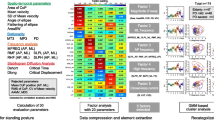Abstract
Objectives
To evaluate the prevalence and management of residual symptoms in recovered BPPV patients.
Methods
We performed a retrospective study on BPPV patients of any of the three semicircular canals. Exclusion criteria were multiple-canal BPPV, refractory BPPV, central nervous system pathologies or other vestibular diseases. Patients were treated with repositioning maneuvers until the vertigo disappeared and evaluated for symptoms of instability at 1 month after resolution. A dynamic computerized posturography was then performed on every patient complaining of residual instability. We analyzed demographic data, the affected semicircular canal, number of repositioning maneuvers, presence of anxiety disorders, and we correlated these variables with the presence of residual disequilibrium 1 month after vertigo resolution.
Results
We included 361 patients. Residual disequilibrium was found in 107 patients (29.6%) with no significant difference between the rates associated with the three semicircular canals (p = 0.73). The group who needed more than one repositioning maneuver (1 maneuver-229 patients, ≥ 2maneuvers-132 patients) showed a significantly higher prevalence of instability (17.9 vs. 50%; p < 0.0001). 47.2% of the patients with anxiety disorders presented with instability symptoms (p = 0,01). Patients older than 65 showed a significantly higher percentage of residual symptoms (23.3 vs. 34.8%; p = 0.03).
Conclusions
Persistence of residual symptoms 1 month after the acute BPPV can be associated with certain risk factors that should be taken into consideration (age, number of repositioning maneuvers needed, anxiety and/or depressive disorders). These patients could benefit of treatment with vestibular rehabilitation.


Similar content being viewed by others
References
von Brevern M, Radtke A, Lezius F et al (2007) Epidemiology of benign paroxysmal positional vertigo: a population based study. J Neurol Neurosurg Psychiatry 78:710–715. https://doi.org/10.1136/jnnp.2006.100420
Balatsouras DG, Ganelis P, Aspris A, Economou NC, Moukos A (2012) Benign paroxysmal positional vertigo associated with Meniere’s disease: epidemiological, pathophysiologic, clinical, and therapeutic aspects. Ann Otol Rhinol Laryngol 121(10):682–688. https://doi.org/10.1177/000348941212101011
Oron Y, Cohen-Atsmoni S, Len A, Roth Y (2015) Treatment of horizontal canal BPPV: pathophysiology, available maneuvers, and recommended treatment. Laryngoscope 125:1959–1964. https://doi.org/10.1002/lary.25138
Yu S, Liu F, Cheng Z, Wang Q (2014) Association between osteoporosis and benign paroxysmal positional vertigo: a systematic review. BMC Neurol 14:110. https://doi.org/10.1186/1471-2377-14-110
Seok JI, Lee HM, Yoo JH, Lee DK (2008) Residual dizziness after successful repositioning treatment in patients with benign paroxysmal positional vertigo. J Clin Neurol 4(3):107–110. https://doi.org/10.3988/jcn.2008.4.3.107
Martellucci S, Pagliuca G, de Vincentiis M, Greco A, De Virgilio A, Nobili Benedetti FM, Gallipoli C, Rosato C, Clemenzi V, Gallo A (2016) Features of residual dizziness after canalith repositioning procedures for benign paroxysmal positional vertigo. Otolaryngol Head Neck Surg 154(4):693–701. https://doi.org/10.1177/0194599815627624
Giommetti G, Lapenna R, Panichi R, Mobaraki PD, Longari F, Ricci G, Faralli M (2017) Residual dizziness after successful repositioning maneuver for idiopathic benign paroxysmal positional vertigo: a review. Audiol Res 7(1):178. https://doi.org/10.4081/audiores.2017.178
Fernández L, Breinbauer HA, Delano PH (2015) Vertigo and Dizziness in the Elderly. Front Neurol 6:144. https://doi.org/10.3389/fneur.2015.00144
Ribeiro KM, Ferreira LM, Freitas RV, Silva CN, Deshpande N, Guerra RO (2016) “Positive to Negative” Dix-Hallpike test and benign paroxysmal positional vertigo recurrence in elderly undergoing canalith repositioning maneuver and vestibular rehabilitation. Int Arch Otorhinolaryngol 20(4): 344–352. https://doi.org/10.1055/s-0036-1572528
Batuecas-Caletrio A, Trinidad-Ruiz G, Zschaeck C, del Pozo de Dios J, de Toro Gil C, Martin-Sanchez L, Martin-Sanz V E (2013) Benign paroxysmal positional vertigo in the elderly. Gerontology 59(5):408–412. https://doi.org/10.1159/000351204
Stambolieva K, Angov G (2006) Postural stability in patients with different durations of benign paroxysmal positional vertigo. Eur Arch Otorhinolaryngol 263(2):118–122. https://doi.org/10.1007/s00405-005-0971-9
Epley JM (1992) The canalith repositioning procedure: for treatment of benign paroxysmal positional vertigo. Otolaryngol Head Neck Surg 107(3):399–404. https://doi.org/10.1177/019459989210700310
Gufoni M, Mastrosimone L, Di Nasso F (1998) Repositioning maneuver in benign paroxysmal vertigo of horizontal semicircular canal. Acta Otorhinolaryngol Ital 18(6):363–367. https://www.ncbi.nlm.nih.gov/pubmed/10388148 (In Italian)
Yacovino DA, Hain TC, Gualtieri F (2009) New therapeutic maneuver for anterior canal benign paroxysmal positional vertigo. J Neurol 256:1851. https://doi.org/10.1007/s00415-009-5208-1
Oda DTM, Ganança CF (2015) Posturografia dinâmica computadorizada na avaliação do equilíbrio corporal de indivíduos com disfunção vestibular. Audiol Commun Res 20(2):89–95.https://doi.org/10.1590/S2317-64312015000200001469
Jacobson GP, Newman CW (1990) The development of the dizziness handicap inventory. Arch Otolaryngol Head Neck Surg 116(4):424–427. https://doi.org/10.1001/archotol.1990.01870040046011
Staab JP, Eckhardt-Henn A, Horii A, Jacob R, Strupp M, Brandt T, Bronstein A (2017) Diagnostic criteria for persistent postural-perceptual dizziness (PPPD): consensus document of the committee for the classification of vestibular disorders of the barany society. J Vestib Res Equilibr Orientation 27(4):191–208. https://doi.org/10.3233/VES-170622
Teggi R, Giordano L, Bondi S, Fabiano B, Bussi M (2011) Residual dizziness after successful repositioning maneuvers for idiopathic benign paroxysmal positional vertigo in the elderly. Eur Arch Otorhinolaryngol 268:507. https://doi.org/10.1007/s00405-010-1422-9
Escher A, Ruffieux C, Maire R (2007) Efficacy of the barbecue maneuver in benign paroxysmal vertigo of the horizontal canal. Eur Arch Otorhinolaryngol 264:1239. https://doi.org/10.1007/s00405-007-0337-6
Mendel B, Bergenius J, Langius A (1999) Dizziness symptom severity and impact on daily living as perceived by patients suffering from peripheral vestibular disorder. Clin Otolaryngol Allied Sci 24:286–293. https://doi.org/10.1046/j.1365-2273.1999.00261.x
Huppert D, Strupp M, Rettinger N et al (2005) Phobic postural vertigo: a long term follow up (5 to 15 years) of 106 patients. J Neurol 252:564–569. https://doi.org/10.1007/s00415-005-0699-x
Author information
Authors and Affiliations
Corresponding author
Ethics declarations
Conflict of interest
The authors declare that there is no conflict of interest.
Rights and permissions
About this article
Cite this article
Vaduva, C., Estéban-Sánchez, J., Sanz-Fernández, R. et al. Prevalence and management of post-BPPV residual symptoms. Eur Arch Otorhinolaryngol 275, 1429–1437 (2018). https://doi.org/10.1007/s00405-018-4980-x
Received:
Accepted:
Published:
Issue Date:
DOI: https://doi.org/10.1007/s00405-018-4980-x




